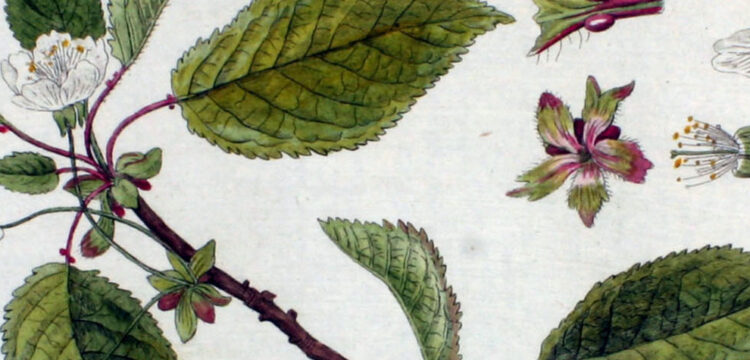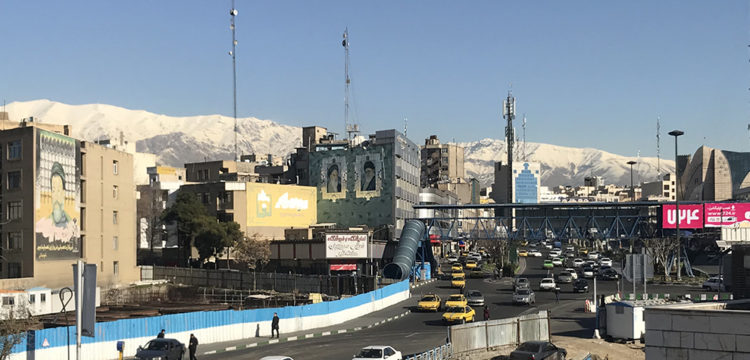Women’s Business
On memories, bazaars and Afghan feminism: a conversation with Hangama Amiri
The work of Afghan-Canadian artist Hangama Amiri (1989, Kabul) is currently on view at T293 gallery in Rome. The exhibition Bazaar, A Recollection of Home explores different topics: politics of globalization; consumer exchanges between the East and the West; social and gender norms within the Afghan bazaars. Amiri extends the works to wider layers of significance, with the aim at celebrating women’s presence in a man-dominated environment.
Alessandra Giacopini: You are now exhibiting at T293 gallery in Rome with Bazaar. A Recollection of Home. The white space is transformed into an image from your past, which reflects your memory of a complex culture. You have been through a lot in your childhood, and as a refugee you moved from country to country, from Afghanistan to Pakistan, Tajikistan, Canada and eventually the USA. I would like to start by thanking you for sharing your past and your memory with us, and for making the story of Afghan women more present in our present.
As a white woman with a privileged status, living in a democratic country, I sometimes give my position and my freedom for granted. In a period of extended and forced distance, we may forget about the world beyond our nose. Afghanistan, to me, has seemed so far for so long. Not to mention Islam. How big can a heart be to be able to carry not only our, but other people’s pain and injustice?
I think that the need for togetherness has never been so strong as during this pandemic period. And it is important to celebrate it. This sense of togetherness is exactly what I perceive by going through your exhibition in Rome. In Bazaar. A Recollection of Home, we discover a world made not only by your intimacy but also by a plurality of other Afghan women’s lives. I can see how powerful women can be when together, even in a male-dominated society.
So I’d like to know what it means for you to be an Afghan artist woman talking nowadays about these topics in the occidental world, and I am also interested in learning how you realized that visual art would have been the best form of communication in your narrative.
Hangama Amiri: As an Afghan-Canadian artist and woman, I have always felt a need to revisit my childhood memories of Afghanistan through my art practice. This feeling has especially resonated with me during this political and economic crisis and I firmly believe that we as artists are in a privileged position when it comes to talking about the politics of representation and the various diasporic communities living within the United States today. I am especially interested in highlighting contemporary Afghan women’s voices and experiences in my work because of the fact that there are a lot of stories from my world, and theirs, that have neither been seen or heard of. This specific cultural perspective is definitely missing within the larger cultural landscape of the United States. Art provides a space for me to center their voices and bring cultural and historic value to them within the contemporary art world by creating paintings on a scale akin to history painting. My work within my exhibition Bazaar, A Recollection of Home at T293 gallery exists on a larger scale for this reason.
I am also intentionally working against the idea of the space of the bazaar as being dominated by men within this new body of work. I am revealing the presence of women within these public spaces, which are often ignored in the western world. When people think of Afghanistan, they think of landscapes obscured by layers of dust and sand and women in burkas. Afghanistan has in fact progressed a lot since the Taliban regime. Today there are female politicians, soccer players, and shop owners. These are the kinds of women that I am interested in. It is true that the dark reality is that a majority of Afghan women do still live in a very male dominated society where they can still be subjected to domestic violence or being beheaded because of adultery or other sexual acts. I am not, however, interested in depicting women as victims of war or of a patriarchal society, but instead as heroines who stand for progress and change. I want my work to project a more hopeful voice in order for it to encourage future generations of Afghan women to bring new representations of the East into being, not for the Western world but for themselves and for their community.
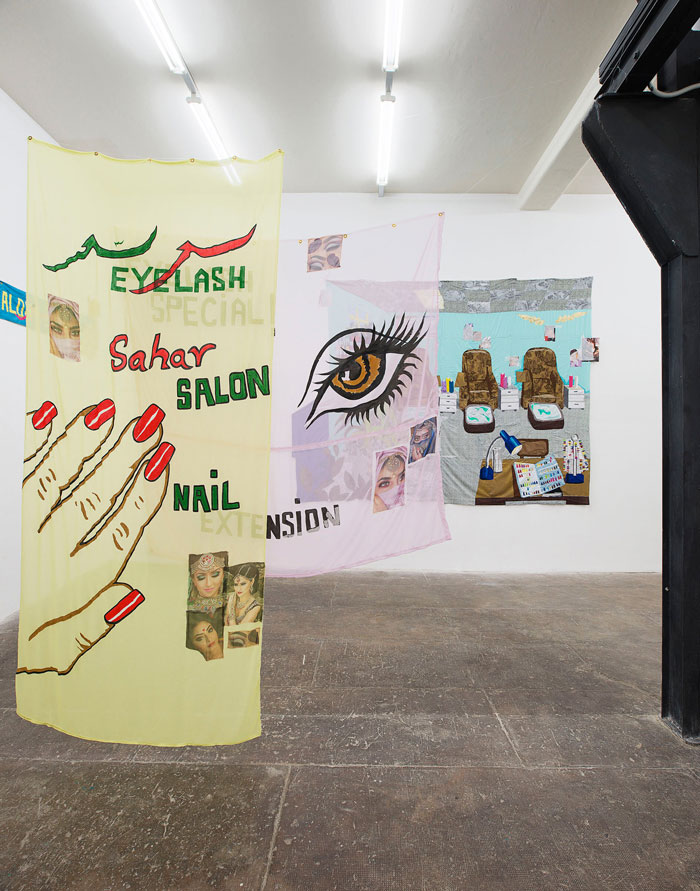
I recognized the power of visual art during my time as a refugee in multiple countries. From Afghanistan, Tajikistan, and Pakistan I remember absorbing the patterns and colors of different kinds of clothing and textiles. I developed an intimate understanding of these cultural materials by learning how to sew alongside my mom and aunts. But, when I started drawing at a young age from my dreams and imagination, I began to realize how little attention was paid to their work and labor in comparison. Drawing as a medium was given more attention and respect than their weaving and sewing. Of course, looking back now, I can easily recognize a division between fine art and craft, but back then I didn’t really understand that fully in the way I do now. So, when I would draw the everyday lives of the people around me while I was a refugee in these countries, all I can remember is how fascinated people were with my ability to capture their likeness on paper. This practice of making drawings and illustrations continued to be a part of me until I decided to go to the Olimov College of Art in Tajikistan. It was there that I started to realize how much more effective painting my stories was when it came to narrating them visually as opposed to writing them. Now that I have moved on to working with fabric, I am able to make these larger connections between the communities of women I worked with while growing up and the stories I am representing. Fabrics worn by different communities of women are now literally sewn, embedded, and gathered together in my work. My memories allow me to imbue meaning into mass produced and Afghani handmade embroidered fabrics by creating new images that recall the smell, time, culture, and social interactions of the communities of women I engaged with throughout my life. In essence, my work brings me closer to them and that is a powerful gesture I hope to continue to build upon as I develop new bodies of work.
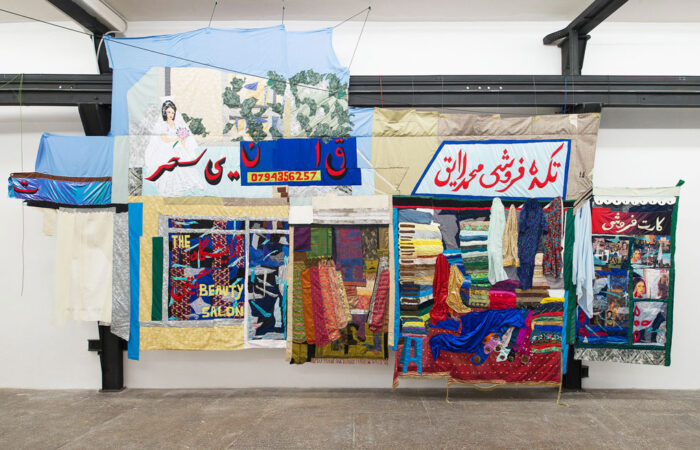
I see your work as a bridge, which connects cultures and identities, but also stories and feelings. It connects not only you with your past, your home, your community and your country, but also all the people interested in your work, all the viewers at your exhibitions, who take in a way part in the installation. You know, in this period there is a topic coming up everywhere, and it’s the notion of care. It is certain something people feel the urgency to talk about, especially in these days of social distancing and lack of resources in medical care. I find your work related to that theme. In fact, your work builds community. And what else, if not the sense of community, can best express the meaning and the importance of care?
When we think of it, we should think of care as an opportunity to be responsible for something or someone. Different cultures should be seen as infinite resources able to enrich people. As you have already written, your exhibition is a tribute to Afghan women’s voices and experiences. Your female figures stand up for themselves, and they show the progress made until now in the history of Afghanistan. Then I see care not only in the attention you put in creating your works, but also in the importance that Afghan women give to beauty. And you highlight it through many of your new works. Can we say that the care of themselves is an action of redemption and rebellion, or even an act of revolution? Can you tell us a bit more about the act of beautification we see going on in the public spaces you represent in some of your artworks?
I am interested in how you brought up care in relation to communal spaces, families, and different cultures. Care is definitely central to how they can survive and thrive. There is also care that goes into the economic exchanges that take place in a beauty parlor. The idea of care in relation to self-beautification is a way for me to reflect on the politics of beauty. During the Taliban regime, self-beautification was something women did not have access to. They were not allowed to be beautiful, radiant, or sensual. After the Taliban regime fell, beauty parlors flourished once again, which in turn gave women the space they needed to care for themselves, the freedom to mingle amongst one another, and opportunity to care for themselves and feel beautiful. That is the statement I am making between these complex relationships of beautification and the public space of the bazaar, which is again very male dominated, but these are the only public spaces women feel they can belong to and be free and happy.
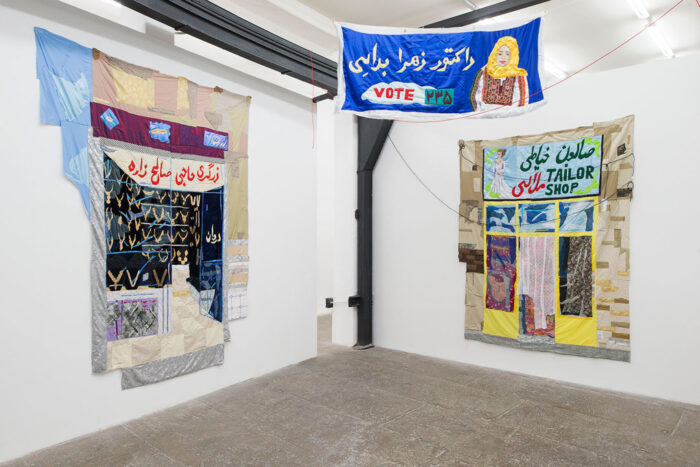
Belonging is indeed another feeling we can experience through your artworks. Viewers can totally immerse themselves in your large-scale installations. When we enter the white space, we break into a landscape made of a series of shops, doors and windows, as for instance the tailor shop or the beauty salon. There is no human presence though. Despite this, we don’t need any figure to feel the vital, chaotic and perhaps noisy life that is now going on around us.
In the second room, on the contrary, we find ourselves in the inside of those “fragmented” places and we meet “fragmented” figures; we imagine to hear their chats, their laughs and to see their beauty and their smiles. We feel we belong to those places as much as you or those women do. I think that the great dimension of the works and their tactile and three-dimensional material help very much to feel this immersive experience. I am very interested in both choices. Indeed, you work your fabrics with a terrific ability. What’s the process you follow when you conceive a new piece?
I have developed a habit of looking at both my own photographs and images from the internet when starting a new project or artwork in my studio. For this specific body of work, I used images that were shared with me from my family members in Afghanistan. I choose to work with photographs because of their flatness. They instantaneously collapse three-dimensional space into a two-dimensional picture plane that helps me better visualize the shapes, colors, and objects I want to highlight in my own compositions. After deciding what source materials to use, I begin sketching with graphite. I build up the drawing with color pencils and markers to a point where I have enough information to create the larger textile artworks.
My textile pieces are informed by the decisions I make in my initial drawings in regards to color and composition, but I don’t limit myself to the sketches. I work with the fabrics that will work best for the overall piece. Sometimes that means abandoning the color scheme of the drawing altogether and instead using a patterned background in place of just a flat color. Working with the technique of applique also allows me to easily transfer my drawing onto the fabric, which keeps the overall composition more open. This helps me decide the scale of the works as well because when I start sewing the different sections together there is no going back in terms of size. I also recognize that my textile pieces are not going to be replicas of my drawings in terms of their materiality, but this is precisely what excites me about fabric. When sewing things by hand or on the machine I let the changes and accidents developing in front of me motivate my decision-making process. I enjoy when something I didn’t expect takes place and it adds to the piece.
Working on a larger scale lets me work through my ideas more freely. It also helps me take advantage of the materiality of the fabrics. Since this body of work needed to feel like an environment, the large scale supported the kinds of interiors and exteriors I wanted to depict. The scale lets me re-enter those spaces in my memory that I want to feel, see, and create. The textile pieces in this show almost envelope you, but there are also these more intimate moments as viewers look closer at the details within the pieces. This intimacy lends fabric its seductive power, but it is the physicality of the material that invites us to touch and feel it. This physicality lends itself to my work because it allows me to give weight and substance to my own memories, which are weightless and immaterial. I am interested in giving these fictional realities from my memory a place where they can become a reality.
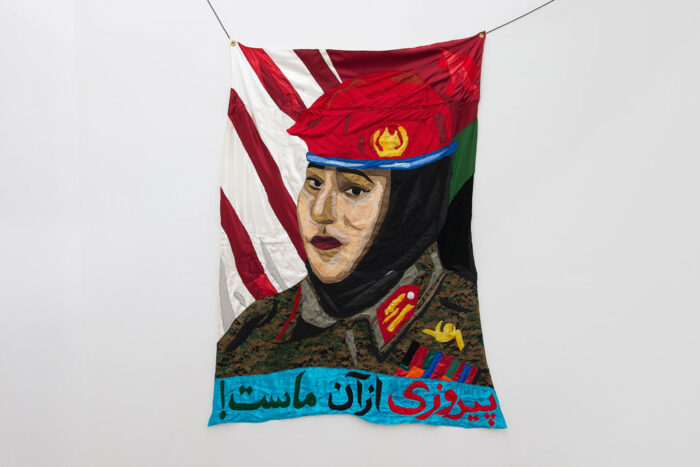
So the transition from drawings to working with fabrics was quite natural for you. In fact, the fabric carries a deeper connotation and a sense of sharing and belonging to a specific culture. Your fabrics come from Afghanistan, India and even America, right? And they are mostly handmade and embroidered, so you can see these beautiful costumes from all over the world, but fragmentation is also a way to break and combine existing boundaries. This is very evident, for example, in the large-scale textile pieces Bazaar (2020).
Fabric is usually seen as the medium of representing dissent and its use is primarily iconic for flags and banners. In fact, we can find textile pieces hanging in the space of your current exhibition as if they were banners of flags, such as Vote (2020) or Sahar, Nail Salon and Eyelash Extensions #3 (2020). Have you ever thought about this aspect while installing them? And text is an ever-present part of your works as well.
Yes, my fabrics come from all of those different countries. If I can’t find culturally specific fabrics online, I do my best to search for them in New York’s fashion district or in one of the many small specialty stores. The store I usually go to is called A.K. Fabrics and the owner of the shop is actually from Afghanistan. I was very happy when I first met him because we talked about the history of textile production in Afghanistan. He mentioned that the textile industry declined during the Russian occupation of Afghanistan in the 1970s when second hand clothes began to be distributed within the country. Conversations like this have helped me think more about the history of fabrics and textiles in my home country. I still visit A.K. Fabrics every time I am in New York and I do so because it gives me an opportunity to connect with the diasporic Afghan communities here in the US.
In regards to Vote (2020) and Sahar, Nail Salon and Eyelash Extensions #3 (2020) hanging in T293, those pieces were intentionally made to look as if they are banners. I wanted to investigate the material relationship between fabric and banners and how banners function when it comes to representational imagery. I was interested in how banners hang in the air. As you can see these banners are not straight, but instead have these weird angles as if they were in motion or flying through the air. I play with the materiality of the fabric in order to represent different surfaces within my work. I used chiffon in Sahar, Nail Salon and Eyelash Extensions #3 (2020) for example, to convey a transparent glass or mirror-like surface that is thin, fragile, and reflective. Since that entire piece is made of thin chiffon, you can see through the images on the chiffon and beyond it. Or I will also use thick fabrics, like in the Vote (2020) banner to lend the piece an opacity and visual weight.
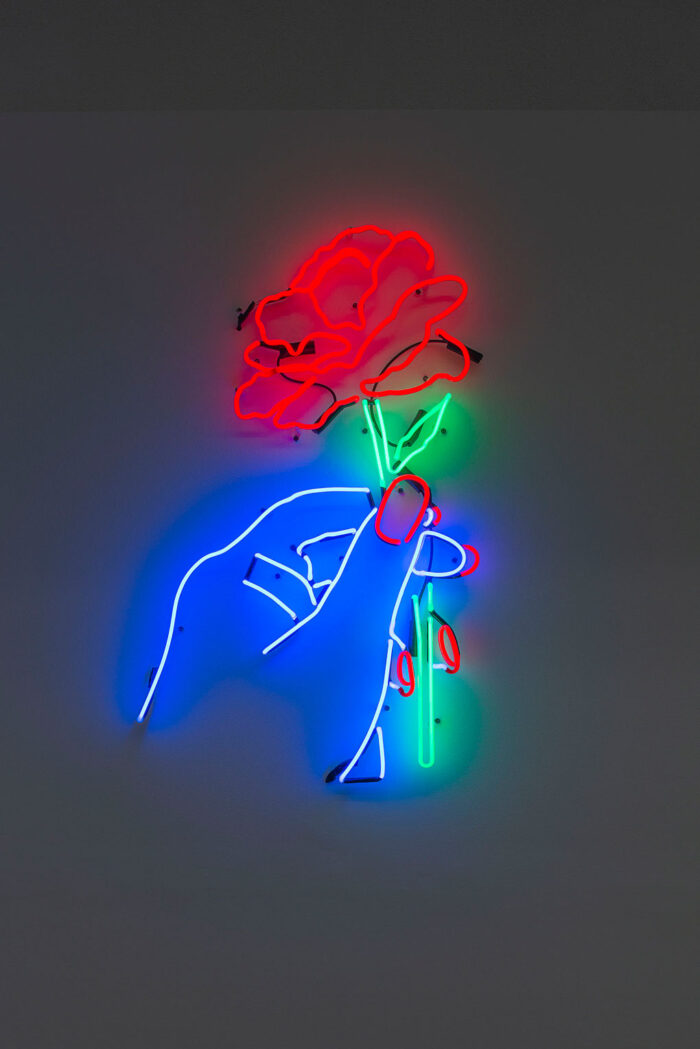
In addition to the monumental textile pieces, however, there is also a neon that welcomes visitors at the entrance to T293. What’s its story?
Neon lights remind me of my nights in Kabul city. These bright lights are used all over the city’s stores and I have even seen them used to make decorative sculptures in wedding halls. Hotel names are also made out of neon lights to attract viewers or cars passing by on the street—their glowing light makes the city feel alive even at night. In this exhibition, I was interested in bringing this element of the city, which is also used by stores and vendors at the bazaar, into my show to make it feel as if my own bazaar is open twenty-four hours a day. The hand delicately holding a rose symbolizes the relationship between aesthetic taste and economic value since there is a certain amount of care and physical touch involved in transforming raw materials into beautiful art objects. The design of this piece comes from the nail salon’s banner, titled Sahar, Nail Salon, #2. I translated the imagery in the first gallery as a way for me to connect the two different gallery spaces. My intention was to interlock the viewers’ experience of this visual element in the first and second gallery and vice versa.
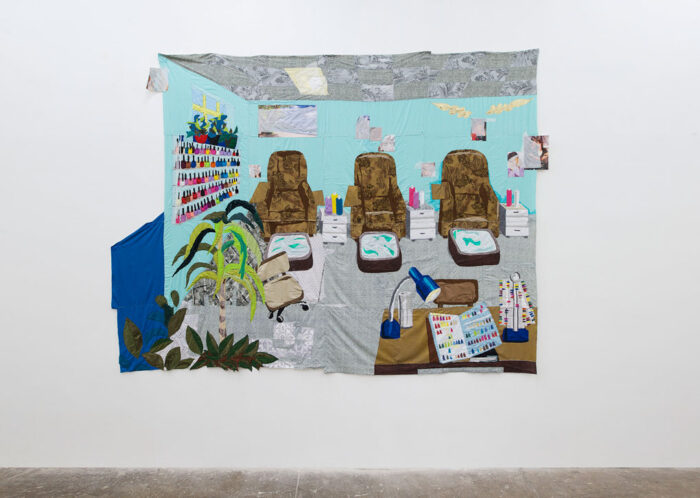
By representing the bazaar, the salons and other sites from your memory, in a mix of fiction and reality, you share with us your hope for a new future. It is as if women are experiencing a rebirth in these places. You know, Hannah Arendt argued that there is a second birth that determines our deep sense of being in the world and this birth is linked to political action, which is also an act of emancipation. I find this thought very close to what you show us. Moreover, your role as an artist is above all a reflection of your political action. So I’d love to end this conversation by asking your opinion on what contemporary Afghan feminism can be nowadays.
Afghan women, unfortunately, still live as secondary figures in a culture where men come first. Even after the Taliban regime, women have struggled to marry who they want, receive an education, and be fully independent. Exploring those spaces of women’s struggles in Afghanistan is what contemporary Afghan feminism can talk about. Women’s liberation is still a huge question there along with women’s safety, security, and freedom of speech. These are basic needs Afghan women are often stripped of and I want to use my art as a tool to create worlds they feel comfortable belonging to.



